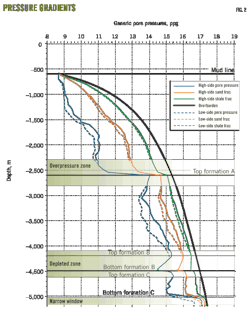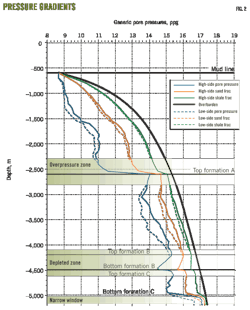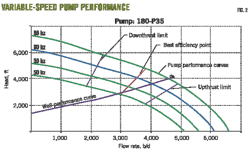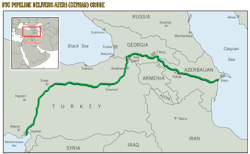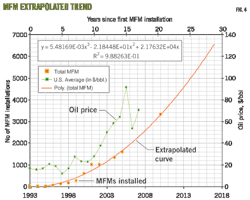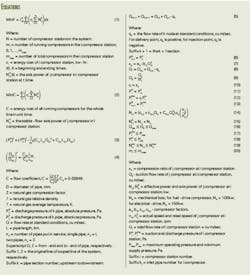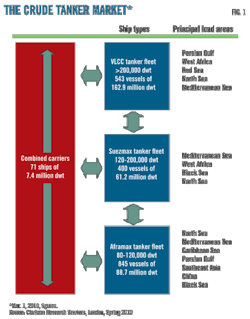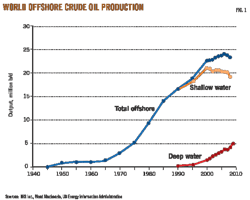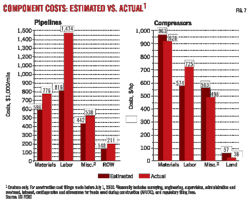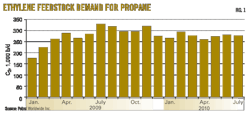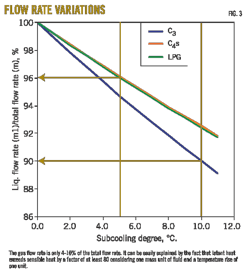Forecast expects continued multiphase flowmeter growth
Gioia Falcone
Texas A&M University
College Station, Tex.
Bob Harrison
Soluzioni Idrocarburi srl
Rome
A forecast based on the trends in sales and installations worldwide indicates that the upstream petroleum industry will install many multiphase flowmeters during the next 5-10 years.
For this fast evolving and technically complex technology, the global market continues to grow quickly.
MFMs offer many claimed capabilities but vendors still face the problems of the slow uptake of MFM technology by the oil and gas industry and the associated barriers to entry into this market.
Multiphase flowmeter market
Multiphase flow metering, which measures the flow rate of each phase in a flow stream,1 ranges from metering wet-gas streams with a high gas content to metering heavy-oil streams.
The first commercial MFMs appeared in the 1990s from a handful of manufacturers. The number of commercial MFM manufactures rises and falls because of mergers and acquisitions that continue unabated, but the appearance of new vendors has maintained the total number of manufacturers at about 20.
MFMs are essential for many field developments because they allow real-time well monitoring, individual well testing, production allocation, and reservoir surveillance. They also provide critical information on well performance such as water breakthrough, gas coning, and inflow characteristics.
MFM applications are diverse, ranging from onshore to offshore, from new development projects to retrofits of declining fields, and from wet gas to heavy-oil streams.
Fig. 1 lists the currently available MFMs in the market along with their key technical characteristics claimed by their manufacturers. MFM history suggests that a universal metering solution does not exist.
Often reported is that the service and support provided by MFM vendors falls short of the mark. The meter hardware requires associated software, training, and customer assistance, yet operators often fail to discover from meter manufacturers why a given installation does not perform as expected.
Operators also complain of poor technical assistance from local MFM vendors because the real expertise resides primarily in the manufacturer's head office. Also vendors frequently offer a full-blown MFM system for applications that may require a simpler, cheaper meter.
Installation trends
When establishing the exact number of MFM installations worldwide, one must distinguish between those installed and currently working, those installed but now discontinued, those ordered but not yet delivered, those delivered but not yet installed, and those used for portable well testing.
MFM vendors consider market information as commercially sensitive and governmental source data vary in quality and quantity.
For example, the US Bureau of Ocean Energy Management, Regulation, and Enforcement provides detailed listings of MFMs and wet-gas meters (WGMs) used in the Gulf of Mexico. The lists include operator, meter size, subsea or topside installation, meter model, type of application, approval date, and whether the meter is still in service.
The Norwegian Petroleum Directorate (NPD), which does not log its data in as much detail, claims there is a 50/50 split between subsea and topside applications off Norway, with subsea meters gaining popularity because of their potential for providing information close to the well. NPD suggests that WGMs make up 10% of all MFMs in operation off Norway.
All Norwegian operators have some MFMs installed, with three manufacturers dominating the local market: Framo/Schlumberger, Roxar/Emerson, and MPM/FMC.
Notwithstanding the difficulty of gathering market data, Figs. 2 and 3 show an estimate of MFM installation trends 1994-2004 and the regional distribution of those installations, respectively.2 3
In 2005, a market researcher estimated that there were more than 1,600 MFM units installed, of which 10% were for mobile well testing and 20% were WGMs.4 Western Europe, US, and Asia-Pacific accounted for 75% of the total number of MFM installations, with the latter seeing a sharp increase in MFM applications and eclipsing the North Sea.
As to the current size of the MFM market, in 2004 Royal Dutch Shell PLC claimed that there were 1 million oil-producing wells worldwide of which 1% may have MFMs by 2010, suggesting that currently there are 10,000 MFMs installed.
A later study claimed the perception that MFM is a mature technology is misplaced because its impact is just beginning to be felt with an estimated market penetration of only 0.3%.5 This would amount to 3,000 meters for 1 million producing wells worldwide.
The authors concur with this later estimate of market size, which is roughly one third of Shell's optimistic forecast. More recently, one estimate is that MFMs facilitate only 12% of global oil and gas production, implying that there is much room for market growth.6
The authors' currently estimate there are 3,314 MFMs and WGMs installed, with Framo/Schlumberger and Roxar/Emerson accounting for two thirds of the global MFM market.
An extrapolation for the next 5-10 years of MFM installations (Fig. 4) suggests that the number of MFM installation may double from the authors' 2010 estimate.
New technology
MFM manufacturers face several serious hurdles for getting their meters to market. It can take anywhere from a fast-track of 5 years to more than 15 years to develop a basic measurement concept to a working meter, for example:7
• 1-5 years of basic research lead to development of a concept.
• 2-5 years of pilot testing lead to development of a prototype.
• 2-5 years of field experience, failures, and successes lead to an initial production model, which then becomes a commercial product.
The slow uptake of technology in the oil and gas industry indicates that it can take another 15 years before market penetration exceeds 50%.8
Although researchers have developed many new metering ideas, it is difficult to pilot test an MFM in the field due to operator risk-aversion and conservative attitudes, especially for those without a technology-based strategy.
Operators often claim poor correlation between performance and innovation as the reason for their not being more proactive in adopting new technology. This fast-follower mentality, which stems from the knowledge that suppliers eventually will have to give access to new technology, delays its implementation.
The observed slow growth in patents is symptomatic of poor intellectual property (IP) protection within the oil and gas industry. Many new technology developers complain that even though they have patents, remarkably similar rival products appear quickly in the market.
All of these factors create barriers to entry into development of new technology for MFMs (Fig. 5).
Patent protection
Meter companies safeguard ownership of IP at all costs. For instance, Roxar reported that it successfully protected its IP by preventing FlowSys from producing, selling, or marketing MFMs for 3 years while receiving almost $2 million in damages.9 10
New technology development is a long-term investment, and as patents have a maximum validity of 20 years, any incremental developments must also be patented.
Yet IP is not just about patents. Companies must also protect the knowledge developed by thorough documentation that is covered by stringent confidentiality procedures. This is termed the IP iceberg (Fig. 6).
Future trends
Figs. 7 and 8, taken from analysts' reports, show that national oil companies control an increasing share of the world's oil and gas reserves, while the influence of the international oil companies is waning.
Opportunities exist for contractors to build relationships with NOCs to enter the MFM markets in their countries. The NOCs primarily need meters for onshore, whereas the IOCs still drive the deepwater and subsea technology arenas.
Major operators have stated a commitment to fully embrace MFM technology for their offshore assets. For example, Petroleo Brasileiro SA (Petrobras) would like to include an MFM on each of its subsea wells and trees.11 Statoil, a pioneer of MFM technology, is determined to maintain brownfield production off Norway at present levels by using MFMs to advance well testing so as to improve reservoir understanding.11
A recent study predicts that companies will deploy 1,000 additional subsea MFMs by 2015,12 which agrees with the trends shown in Figs. 9 and 10 that highlight the industry's increasing dependence on deepwater exploitation.
More cost effective drilling, installation, and intervention, and proven subsea boosting will be paramount to enable new deepwater projects. The new developments with longer subsea-well tiebacks to host facilities and thence to market will need flow assurance, reliable communications and sufficient power supply between the wells and the host and the more cost effective subsea flowlines.
MFM costs
The capital and operating costs for MFMs is much less than for conventional metering hardware, but occasionally projects also will need conventional hardware and MFMs will be an extra cost.
In 2008, MFM prices were $50,00-400,000, depending on the performance specification,6 but operators have quoted meter prices of $1-4 million for subsea or special applications with corrosion-resistant materials and for greater flow rates.
A subsea MFM in a tieback development 10 km from the host platform could reduce capital expenditures (capex) by an estimated 62% because of the elimination of test lines. The MFM also would improve production system management, increasing by 6-9% the amount of oil recovered.13
Studies indicate that operating expenses (opex) for an MFM is about 25% of the cost of the meter itself for the first year, then $10,000-40,000/year for both onshore and topsides applications.14
Fig. 11 qualitatively shows an optimum range of acceptable uncertainty, cost, and risk that an operator needs to assess for a given project. Operators want MFM technology to evolve to where they can afford to install a dedicated meter on each well, but this will not happen unless MFM prices fall into the $20,000-60,000 range, which is a long way from present MFM prices.
Spending on subsea metering, processing, and boosting will increase as governments continue to encourage operators to improve recovery factors from historic norms. Such improved oil recovery initiatives increase the need for better power supplies, higher wet-gas compression efficiency, and improved reliability of subsea modules via preventative maintenance programs.
The associated higher costs mean operators are reluctant to embrace these new technologies, which are unproven in their eyes, and there is resistance to carry out the necessary pilot studies.
A forecast of increasing expenditure on subsea MFM is $212 million, $364 million, and $548 million for the periods 2003-07, 2008-12, and 2013-17, respectively (Fig 12).12
New market needs
Future growth in the MFM market could include new meters for monitoring injected supercritical CO2 in carbon capture and underground sequestration projects. New meters also are required for geothermal exploitation, to monitor cycled fluids and recovered heat, and managed pressure drilling for real-time mud measurements when drilling through gas hydrates.
Operators have ranked highly clamp-on meters in their wish list because these meters have a negligible effect on an existing facility's layout and, for subsea applications, one could attach these meters onto seabed flowlines with remotely operated vehicles.
Unfortunately, relatively few researchers have proposed such meters to date, given the technical challenge of measuring flow through the pipe wall, but it is hoped that future research will address this application.
References
1. Falcone, G., et al., Multiphase Flow Metering: Principles and Applications, Elsevier, Developments of Petroleum Science series, October 2009.
2. State of the art multiphase flow metering, API Publication 2566, 1st Edition, May 2004.
3. Mehdizadeh, P., "Wet gas, multiphase meters enable more deepwater production," OGJ, May 23, 2005, p. 48.
4. Falcone, G., et al., "Multiphase flow metering: 4 years on," 23rd North Sea Flow Measurement Workshop, Tonsberg, Norway, Oct. 18-21, 2005.
5. Kratirov, V., et al., "Neftemer, a clamp clamp-on multiphase meter for cost cost-effective well monitoring," Neftemer Ltd., Oct. 21, 2008.
6. "Experiences with Intellectual Property Rights (IPR)," Roxar, Mar. 19, 2009.
7. "Roxar protects its industry-leading multiphase flow meter technologies in Norwegian Supreme Court Ruling," Roxar news release, Nov. 29, 2005.
8. "A new regime for innovation and technology management in the E&P industry," McKinsey Research Project, July 31, 2001.
9. "Framo Energy and Schlumberger sold 1200 multiphase flow meters worldwide," Offshore Energy Today, Norway, http://www.offshoreenergytoday.com/, July 6, 2009.
10. Roxar ASA 2008/2013 subordinated PIK bond issue, investor presentation, Apr. 24, 2008.
11. Vieugue, V., "The growth of multiphase meters and the key challenges they are addressing," Russian Oil & Gas Technologies, May 25, 2010.
12. The subsea processing game-changer report 2008-2017, Douglas Westwood Ltd. April 2008.
13. The world deepwater report 2000-2004, Douglas-Westwood Ltd., 2004.
14. Sheers, L., "Multi-phase flow metering—on its way from nursing to mature technology," Hydrocarbon Production Accounting Workshop, Moscow, Dec. 16-17, 2008.
The authors
More Oil & Gas Journal Current Issue Articles
More Oil & Gas Journal Archives Issue Articles
View Oil and Gas Articles on PennEnergy.com
